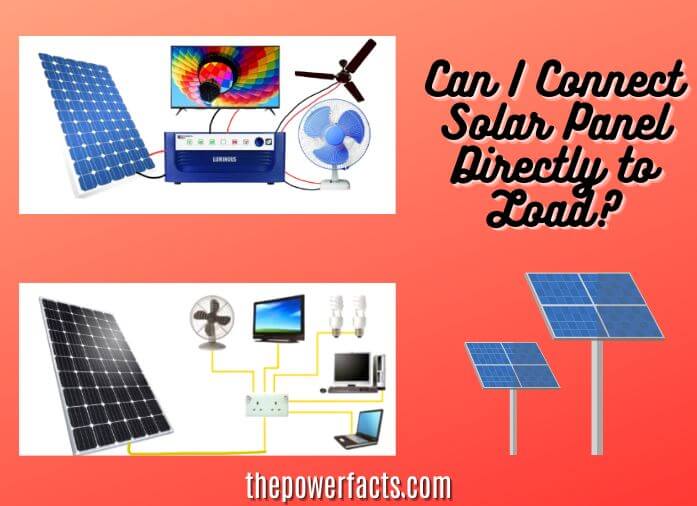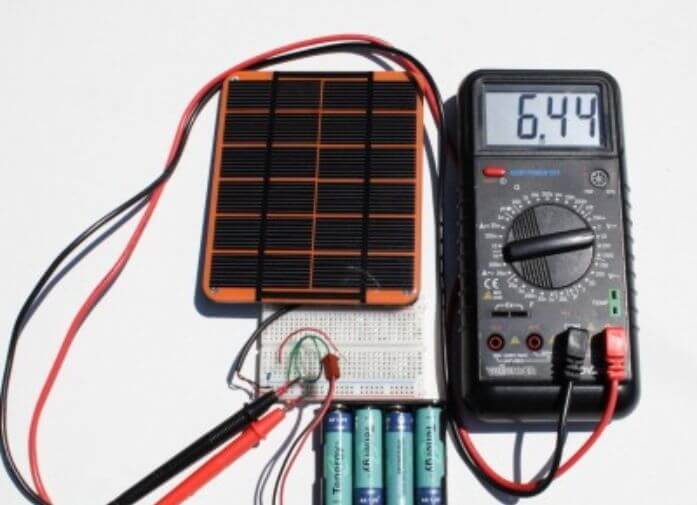As the cost of electricity continues to rise, more and more people are looking for ways to reduce their energy consumption. One popular way to do this is by installing solar panels. Solar panels can be used to generate electricity from the sun, which can then be used to power your home or business.

But what if you want to use solar panels to power your home or business without being connected to the grid? Is it possible to connect solar panels directly to your load (i.e., your appliances and electronics)? The answer is yes!
- Choose the right solar panel for your needs;
- Connect the positive lead of the solar panel to the positive terminal of the load and connect the negative lead of the solar panel to the negative terminal of the load;
- Make sure that all connections are secure and there are no bare wires exposed;
- That’s it! Your solar panel is now connected directly to your load and should be providing power to it.
Can You Draw Power Directly from Solar Panels?
Solar panels are a great way to generate renewable energy, but can you actually draw power directly from them? The answer is yes! Solar panels are made up of glass and photovoltaic cells, which use sunlight to generate electricity.
This electricity can then be used to power your home or business. There are a few things to keep in mind when using solar panels to generate power, however. First, solar panels need direct sunlight to work effectively.
If your area doesn’t get a lot of suns, you may not be able to generate enough power to meet your needs. Additionally, solar panels only generate electricity when they are exposed to light. So if you live in an area with long winters and short summers, you may not be able to rely on solar panels for all of your energy needs.
There are many factors that affect solar panel output, but one of the most significant is the season. In winter, panels may produce less due to shorter days and lower sun angles, while in summer they may produce more due to longer days and higher sun angles.
Can I Connect Solar Panel Directly to the Inverter?
Solar panels and inverters are two key components in a photovoltaic (PV) system. Solar panels convert sunlight into direct current (DC) electricity, while inverters convert DC electricity into alternating current (AC), which is the type of electricity used in homes and businesses.
In most PV systems, solar panels are connected to an inverter through cables.
The inverter then converts the DC electricity produced by the solar panels into AC electricity. In some cases, however, it may be possible to connect solar panels directly to an inverter. This type of connection is called a “direct connection.”
Direct connections between solar panels and inverters are not common because they can be less efficient than systems that use cables to connect the two components. Additionally, direct connections can pose safety risks if the electrical currents produced by the solar panel are too high for the inverter to handle safely. For these reasons, it is important to consult with a qualified PV installer before connecting solar panels directly to an inverter.
Does a Solar Panel Need a Load?
No, a solar panel does not need a load in order to function. A load is only required when the solar panel is used to power an electrical device. When the panel is exposed to sunlight, it produces electricity that can be stored in batteries or used to directly power devices. Solar panels are most efficient at producing electricity when they are directly facing the sun.
Can We Use Solar Panel Directly Without Battery?

Solar panels are a great way to generate electricity without harming the environment. However, many people are unsure if they can be used without batteries. The answer is yes, solar panels can be used without batteries!
Here’s how: Solar panels work by converting sunlight into electrical energy. This process is called photovoltaic (PV) generation.
PV systems can either be grid-tied or off-grid. Grid-tied systems are connected to the utility power grid and use batteries as backup power during outages. Off-grid systems are not connected to the utility power grid and must rely on batteries for storage.
Batteries are not required for solar panel systems, but they do have their benefits. Batteries store excess electricity generated by the solar panels so that they can be used at night or during periods of low sun exposure. This helps to ensure a consistent supply of electricity even when the sun isn’t shining brightly.
Batteries also provide backup power in case of a power outage. Solar panel systems that are not connected to the utility grid can function without batteries, but they may not be as reliable. These types of systems are called stand-alone PV systems.
Stand-alone PV systems typically have a lower capacity than grid-tied or off-grid systems and may only be able to provide a limited amount of electricity.
How to Use Solar Panel Directly Without Battery?
The solar panel can be used without batteries in some cases. For example, if you have a solar-powered calculator, the solar panel is directly connected to the device and charges it without using a battery. Some homes have solar panels installed that are also directly connected to the home’s electrical system; the electricity produced by the solar panels goes directly into powering the home, and any excess is sent back into the power grid.
How to Install Solar Panels And Inverters by Yourself?
There are two main types of solar panel systems: those that are connected to the grid, and those that are not. Grid-connected solar panel systems are the most common type of system, and they allow you to sell any excess electricity you generate back to the utility company. Stand-alone solar panel systems are not connected to the grid, and so any excess electricity must be stored in batteries.
First Step
The first step in installing either type of system is to determine how much power you will need. This will depend on your energy usage and whether or not you want to offset all or just a portion of your consumption. Once you know how much power you need, you can select the appropriate size and type of solar panels as well as the number of batteries (if applicable).
Second Step
Next, you will need to install the panels themselves. This involves mounting them on your roof or another sunny location and connecting them together using a wiring. If you have a grid-connected system, this is also when you will connect your system to the utility company’s power lines.
Last Step
Finally, if you have a stand-alone system, this is when you will install your inverter which converts DC current from the batteries into AC current for use in your home.
How to Connect Solar Panels?
If you’re looking to save on your energy bill and help the environment at the same time, solar panels are a great option. But how do you go about connecting them? Here’s a step-by-step guide:
1. Decide where you want to install your solar panels. Ideally, they should be in a sunny spot that isn’t obstructed by trees or other buildings.
2. Once you have a location picked out, it’s time to start installing the panels. Begin by mounting the brackets that will hold the panels in place. Then, connect the wires from the panels to an inverter box.
3. The last step is to hook up the inverter box to your home’s electrical system. This can be done by working with a qualified electrician. Once everything is properly connected, you’ll be able to start using solar power for your home!
Can You Plug Directly into a Solar Panel?
If you’re considering using solar power to run your home or business, you may be wondering if it’s possible to plug directly into a solar panel. The answer is yes! With a little bit of planning and the right equipment, you can set up your own direct solar connection.
Here’s what you’ll need: A solar panel rated for the amount of power you need An inverter that converts DC power from the solar panel to AC power that can be used by your appliances and lights.
Appropriate cabling to connect the inverter to the solar panel and then from the inverter to your electrical system With this basic setup, you’ll be able to take advantage of free, renewable energy from the sun. Just make sure that your solar panel is sized properly for your needs – otherwise, you may find yourself with an unreliable power source or one that doesn’t provide enough energy for all of your needs.
Can You Run an Appliance Directly from a Solar Panel?
Solar panels are a great way to generate renewable energy, but can you run an appliance directly from a solar panel? The answer is yes, but there are a few things to keep in mind.
| First | The solar panel must be able to generate enough power to run the appliance. This will vary depending on the appliance and the size of the solar panel. |
| Second | You’ll need to connect the solar panel to the appliance using an inverter. An inverter converts direct current (DC) from the solar panel into alternating current (AC), which is what most appliances use. |
| Finally | Make sure that your home’s electrical system can handle the additional load from the solar-powered appliance. With these considerations in mind, running an appliance directly from a solar panel is definitely possible. So if you’re looking for a way to go green and save some money on your energy bills, consider investing in some solar panels! |
Solar PV Direct to Heating Element
Solar PV Direct to Heating Element: In this system, a solar PV array is used to directly heat an element in the space being heated. This can be done by circulating fluid through a heating element that is exposed to sunlight, or by using the PV array to power a fan that blows air across a heating element. The advantage of this system is that it eliminates the need for a separate solar thermal collector and associated piping, making it simpler and less expensive.
The disadvantage is that the efficiency of the system is lower than a traditional solar thermal system because some of the energy from the PV array is lost in converting it from electricity to heat.
Conclusion
Yes, you can connect your solar panels directly to your load. This can be done by using a positive and negative lead from your solar panel to the positive and negative terminals of your load. You will need to make sure that the amperage rating of your solar panel is greater than the amperage rating of your load.